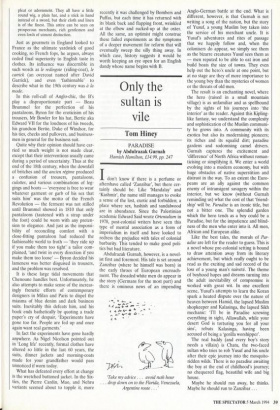We order this matter better in England
Andro Linklater
A HISTORY OF MEN'S FASHION by Farid Chenoune Flammarion, £50, pp. 336 If it was shame that drove Adam to cover his nakedness, what prompted him to make his modest apron from the fig-leaf? Eden must have boasted palm leaves, rushes and bark, any of which, worked or woven, would have served his purpose. Presum- ably, therefore, he was attracted by the leafs glossy green colour, or its gaily scalloped shape, or its soft, cool texture, or the convenience of its size. In other words, even in man's first attempt at clothing, vanity, frivolity and sensuality played a crucial part.
The Puritan mind, yearning as ever to get back to basics, might prefer to believe that it is possible to dress plainly without giving way to these weaknesses, but no one is exempt. In Farid Chenoune's well- illustrated, entertaining and fittingly super- ficial history, male fashion is shown to embrace everyone, from mincing poets and sexually amorphous designers to tweedy princes and pinstriped 'fogies'. A slovenly dresser, groping in the eyelid-encrusted dawn for the corrugations of corduroy rather than the fretwork of threadbare denim, may not be aware of its ripples the rivalry of Versace and Gaultier, the resurrection of the flare, or the death of grunge — but he is still borne along by that vast tide which specifies zips, soft collars, and jackets in place of flies, starched stick- ups and frock-coats.
It is Chenoune's paradoxical thesis that the arbiter of male fashion, the moon that determines its ebb and flow, is the most puritanically minded country in Europe:
England [he declares in his opening sen- tence] is the historical and legendary focal point of men's fashion for over 200 years.
As a Frenchman, he grounds his case on the extraordinary influence English taste has had on his own countrymen.
He dates the beginning of this mastery to the mid-18th century when progressive thinkers in France discerned across the Channel a democratic and sartorial ideal, in which the aristocracy ran their estates, the bourgeoisie ran the country, and both disguised their wealth by wearing nothing more elaborate than a small coat they call a frock, that is, without
pleat or adornmeht. They all have a little round wig, a plain hat, and a stick in hand instead of a sword, but their cloth and linen is of the finest. This attire can be seen on prosperous merchants, rich gentlemen and even lords of utmost distinction.
Just as gourmets in England looked to France as the ultimate yardstick of good cooking, so French fops, he argues, always ceded final superiority to English taste in clothes. Its influence was discernible in such words as le redingote (riding-coat), le carrick (an overcoat named after David Garrick), and even 'fashionable' to describe what in the 19th century was d la mode.
In this roll-call of Anglo-chic, the B's play a disproportionate part — Beau Brummel for the perfection of his pantaloons, Byron for the eroticisim of his trousers, Mr Bowler for his hat, Bertie aka Edward VII for the loudness of his tweeds, his grandson Bertie, Duke of Windsor, for his ties, checks and pullovers, and business- men in general for the business suit.
Quite why their opinion should have car- ried so much weight is not made clear, except that their interventions usually came during a period of uncertainty. Thus at the end of the 18th century, when the downfall of britches and the ancien regime produced a confusion of trousers, pantaloons, culottes, and various combinations of leg- gings and boots — 'everyone is free to wear whatever garment or garb of his sex that suits him' was the motto of the French Revolution — the ferment was not stilled until Brummel showed in 1810 that only pantaloons (tautened with a strap under the foot) could be worn with any preten- sion to elegance. And just as the impossi- bility of reconciling comfort with a close-fitting pantaloon had reduced the fashionable world to froth — 'they ride up if you make them too tight' a tailor com- plained, 'and twist in every direction if you make them too loose' — Byron decided his lameness was better disguised in trousers, and the problem was resolved.
It is these large tidal movements that Chenoune handles best. Unfortunately, he also attempts to make sense of the increas- ingly frenetic efforts of contemporary designers in Milan and Paris to dispel the miasma of blue denim and dark business suits. Inevitably this defeats him, and his book ends bathetically by quoting a trade paper's cry of despair, 'Experiments have gone too far. People are fed up and once again want real garments.'
In, fact the experiments have gone hardly anywhere. As Nigel Nicolson pointed out in 'Long life' recently, formal clothes have altered so little in the last 60 years, the suits, dinner jackets and morning-coats made for your grandfather would pass unnoticed if worn today.
What has defeated every effort at change is the wretched buttoned jacket. In the Six- ties, the Pierre Cardin, Mao, and Nehru variants seemed about to topple it, more recently it was challenged by Bombers and Puffas, but each time it has returned with its blank back and flapping front, wrinkled at the elbow and nicked-up at the oxter. All the same, an optimist might construe these failed experiments as the symptoms of a deeper movement for reform that will eventually sweep the silly thing away. In which case, history suggests it would be worth keeping an eye open for an English dandy whose name begins with B.



























































 Previous page
Previous page